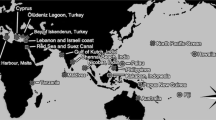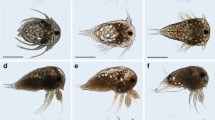Abstract
Larvae of the stone crab,Menippe mercenaria Say, were reared from egg to a true crab stage in 27 days on a diet ofArtemia nauplii. They were successfully cultured in swarms and placed in small compartments where their individual development was studied. Six zoeal stages were found and described, although only five are believed to occur normally in nature. One molt per zoeal stage was noted, and from 3 to 6 days were spent in each stage. Pre-zoeae were observed but these did not molt into a first stage. Such diagnostic characters as size and shape of antennae, and segment and seta numbers of endopodites, maxillules, maxillae and second maxillipeds, were constant in all zoeal stages. Telson appearance and chromatophore occurrence may also be helpful in identification. Comparisons were also made between known xanthid zoeae andMenippe zoeae. Experiments on salinity and temperature tolerance of the zoeae indicate that in a temperature range of 23 to 25°C, zoeae may not be able to survive in salinities of 27‰ or lower.
Similar content being viewed by others
Literature Cited
Aikawa, H.. 1929. On larval forms of some Brachyura.Rec. Oceanogr. Wks. Japan 2:17–55.
— 1937. Further notes on brachyuran larvae.Rec. Oceanogr. Wks. Japan 9(1):87–162.
Binford, R. 1912. The germ cells and the process of fertilization in the crab,Menippe mercenaria. Dissertation, The Johns Hopkins Univ. 51 pp.
Broad, A. C.. 1957. The relationship between diet and larval development ofPalaemonetes.Biol. Bull. 112:162–70.
Cannon, H. G. 1937. A new biological stain for general purposes.Nature. 139–549.
Chamberlain, N. A. 1957. Larval development of the mud crab,Neopanope texana sayi (Smith).Biol. Bull. 113:338.
Connolly C. J.. 1925. The larval stages and megalops ofRhithropanopeus harrisi, (Gould).Contr. Canad. Biol. N. S. 2(15):327–34.
Costlow, J. D., Jr. andC. G. Bookhout. 1959. The larval development ofCallinectes sapidus Rathbun reared in the laboratory.Biol. Bull. 116:373–96.
Hart, J.. 1935. The larval development of British Columbia Brachyura. I: Xanthidae, Pinnotheridae (in part) and Grapsidae.Canad. Jour. Res. 12:411–32.
Hay, W. P. andC. A. Shore. 1918. The decapod crustaceans of Beaufort, N. C.,U. S. Bur. Fish. Bull. 35:371–475.
Hyman, O. W.. 1925. Studies on the larvae of crabs of the family Xanthidae.Proc. U. S. Nat. Mus. 67(Art. 3):1–22.
Lebour, M. V. 1922. The larval stages of the Plymouth Brachyura.Proc. Zool. Soc. London, 473–560.
Rathbun, Mary J. 1930. The Cancroid crabs of America of the families Euryalidae, Portunidae, Atelecyclidae, Cancridae and Xanthidae.U. S. Nat. Mus. Bull. (152):1–699.
Rees, G. H. 1959. Larval development of the sand crab,Emerita talpoida (Say), in the laboratory.Biol. Bull. 117:356–70.
Thompson, T. E. 1958. Observations on the radula ofAdalaria proxima.Proc. Malacological Soc. London, 33(2):49–56.
Author information
Authors and Affiliations
Rights and permissions
About this article
Cite this article
Porter, H.J. Zoeal stages of the stone crab,Menippe mercenaria Say. Chesapeake Science 1, 168–177 (1960). https://doi.org/10.2307/1350394
Issue Date:
DOI: https://doi.org/10.2307/1350394




